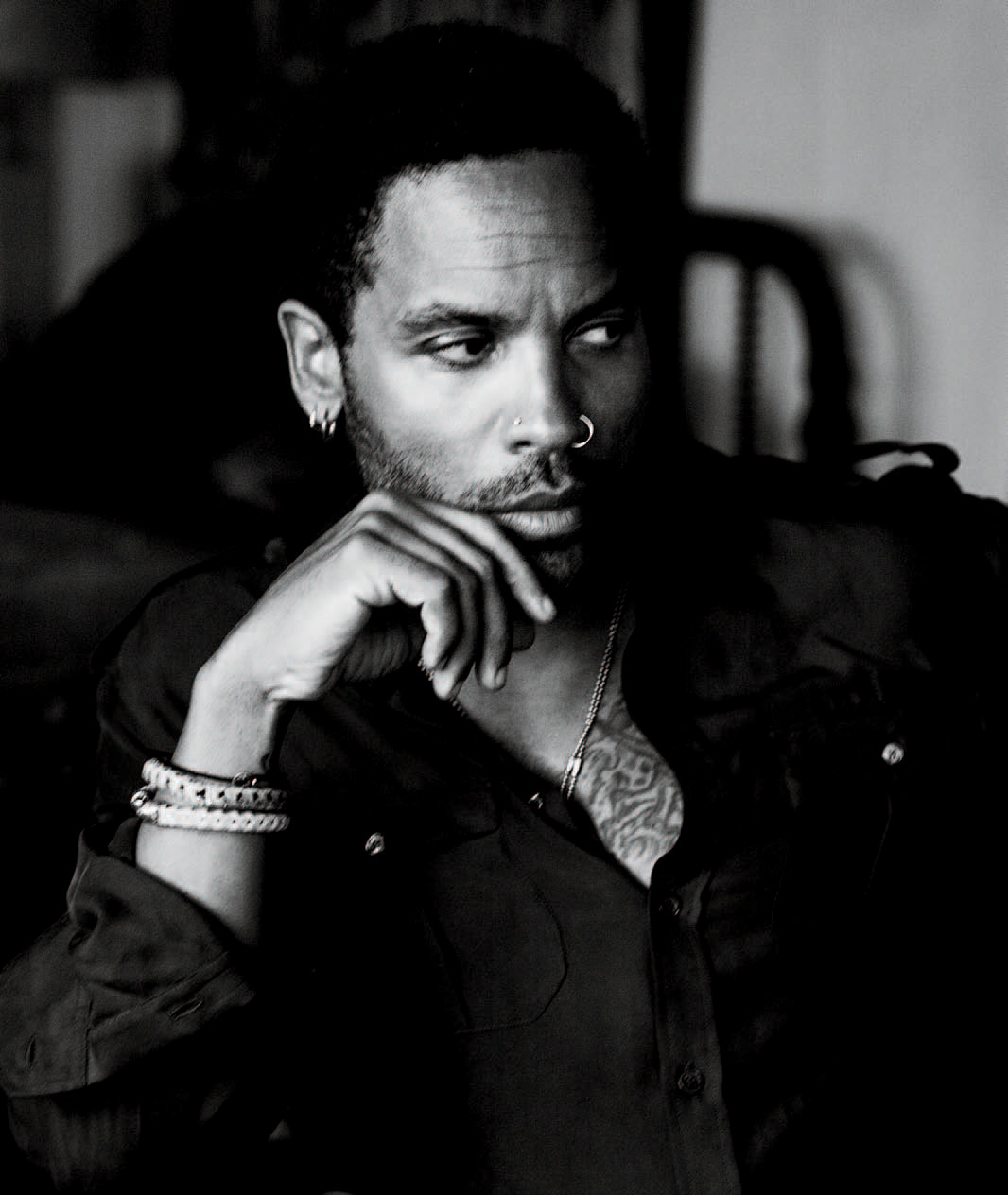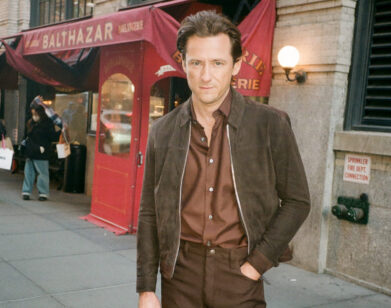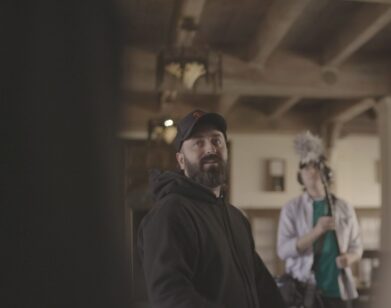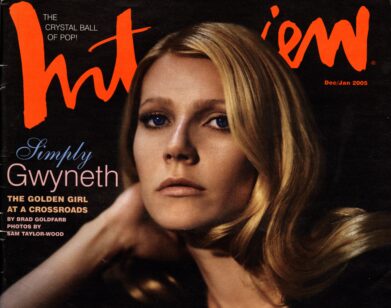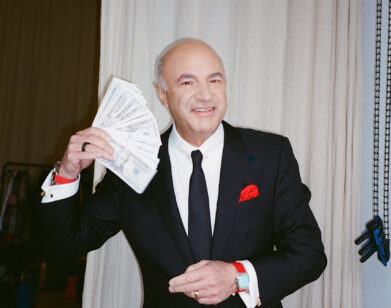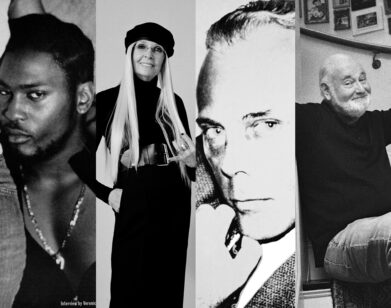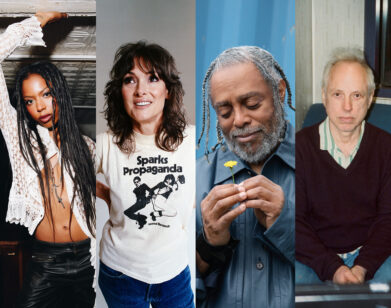Lenny Kravitz
WITH ACTING, IT’S NOT JUST ABOUT ME. I LOVE BEING IN THAT Position, because with the music, it’s always about me.Lenny Kravitz
ABOVE: LENNY KRAVITZ IN MIAMI, JULY 2011. PHOTOS BY GREGORY HARRIS, STYLING BY VANESSA CHOW.
This past November, Lenny Kravitz was awarded one of France’s highest accolades when he was made an officer of the Order of Arts and Letters, an honor he received because, according to French culture minister Frédéric Mitterrand, he had freed himself “from the barriers between black and white sound.” Indeed, Kravitz has a long history with the French, who embraced the retro ’60s vibe of his 1989 debut album, Let Love Rule, at a time when most of America didn’t know what to make of it. In fact, Kravitz even lives in Paris for several months a year.
Kravitz accepted this mark of distinction just a few months after releasing his ninth album, the expansive Black and White America (Atlantic/Roadrunner), which he recorded at his beach-front studio in the Bahamas (and which, tellingly, has risen higher on the charts in France than in the U.S.). With its angular guitar riffs and smooth vocals, Black and White America revisits the vintage rock-funk fusion of Kravitz’s early days. The album also draws heavily on other aspects of Kravitz’s past, including his upbringing as the child of actress Roxie Roker and TV producer Sy Kravitz, and growing up biracial as he traversed a variety of different (and disparate) spheres.
While Kravitz, who turns 48 later this spring, says he has spent a lot of time “laying low” recently, he has been anything but idle. His design firm, Kravitz Design, a boutique business he started in 2003, counts Philippe Starck and a handful of high-end hotels amongst its clients. In the four years since his last album, Kravitz has also delved into acting, offering up a brief but soulful performance as a male nurse in Lee Daniels’s Academy Award–winning drama Precious (2009). This month, he follows that up with a role in Gary Ross’s highly anticipated, post-apocalyptic thriller The Hunger Games, based on the wildly successful young-adult book series by Suzanne Collins that tracks the participants in a surrealistic adolescent death-match game show. In the film, Kravitz plays Cinna, a flamboyant stylist who dresses one of the movie’s young fighter protagonists, Katniss Everdeen (played by Jennifer Lawrence), in exuberant, flaming ensembles (one bejeweled gown is literally on fire). It may seem like an unexpected turn for an alpha-male sex-symbol guitar hero, but then again, if anyone has mastered flouting expectations, it’s Kravitz. He recently spoke with R&B singer, producer, and longtime friend Raphael Saadiq.
RAPHAEL SAADIQ: So how did you wind up in Hunger Games?
LENNY KRAVITZ: Gary [Ross] saw Precious and said that he liked the character of Nurse John, so he thought I’d be right for the role in Hunger Games since Cinna is somebody who is looking out for somebody and is a support figure, too. So he called me down here in the Bahamas— I was actually making the album at the time. He said, “Hi, I’m making this movie called The Hunger Games. I think you’d be great. If you want it, you’ve got the part.” No audition. I was really flattered, but I had not read the book. So I downloaded it. I remember I started it late one night and I needed to go to bed—I was tired and had been recording all day and night—but I couldn’t stop reading because I was captured by the story. So I finished the book and called him back and said, “I’d love to do it.” You know, the film definitely represents these times—from government on down to reality television. It’s interesting that we’re living in these times. Really, when you go back to being in junior high school and reading George Orwell’s 1984, you’re, like, “Man, here were are . . .” Our characters have changed, our sensibilities. We’re definitely morphing into something different.
SAADIQ: Do you think anything like The Hunger Games could ever actually happen?
KRAVITZ: You know what’s funny? A lot of reality television started in Europe—things like Big Brother, where you had random people living in a house together and all this stuff started happening. And then you had all the gladiator stuff and the competitions. I remember saying, “One day we’re going to watch people fight to the death, like Roman times. Instead of being in a coliseum, we’re going to watch it on TV .” It sounds like a really far-fetched and politically incorrect statement at this point, but who knows how twisted we’re going to get? Because our appetite grows, our thirst for excitement . . . So who knows in the next 50 years where we’re gonna go? Hopefully we’ll go somewhere smarter and more beautiful and more peaceful, but that’s not where we’re headed at the moment. Things that would shock us years ago are like nothing now.
SAADIQ: When I saw you pop up in Precious, I was like, “That’s cool because Lenny’s still Lenny.” How do you deal with that? Do you pick films in which you can remain Lenny but sometimes bust outside of your own character a little bit, too?
KRAVITZ: Well, yeah. I mean, I definitely want to jump outside of my character. Precious was offered to me by Lee Daniels. I was out one night, and I met Lee—he was with Julian Schnabel, who is a friend of mine. So Julian brought Lee over, and Lee said, “I’ve been wanting to work with you, but I couldn’t find you. But I know your mother’s work.” So I said, “Oh, you used to watch The Jeffersons . . .” And he said, “No, I know your mother’s theater work.” Then I got really impressed with him because this guy knew her from back in the day. He said, “If you have just one drop of her talent, you’re going to be good. I want you to do this film with me.” I only had two days to work because I was on tour, so I did that role in Precious, and I really loved doing it.
SAADIQ: It’s probably like how some of my actor friends like to play music because nobody’s telling them what to do. It’s different.
KRAVITZ: Exactly. It’s a release. I’m just looking for interesting roles and giving acting the respect it deserves. I’m starting out slowly, and I’ll just keep doing things like this and learning until I find the right thing. Then I’ll do my own film—I’m writing a film that I want to direct, which is something very close to me. You might feel the same way, but music, for me, is completely self-indulgent. I write it, I play the instruments, I arrange it, I produce it. It’s all about me—as it should be. But when it comes to acting, it’s about creating a character and bringing forth a director’s vision. It’s a weird feeling, because with acting, it’s just not about me. I love being in that position, because with the music, it’s always about me.
SAADIQ: Would you ever want to do a comedy?
KRAVITZ: Oh, I love comedy. I like dark comedies. Things like . . . Well, obviously, Woody Allen and Wes Anderson. The Royal Tenenbaums [2001] is one of my favorites. And I actually just watched Fantastic Mr. Fox [2009]. George Clooney and Meryl Streep were flawless. I love Wes’s work. I mean, if I ever got to work with somebody like him, it would be a dream. I did this thing for Funny or Die called “Lenny Kravitz Is Angry.” My daughter and I were talking, and we thought it would be really funny. She said, “You know, you’re known as this Let Love Rule guy—Mr. Love and Peace. What if you just kind of go off on people?” So that’s how it happened. It was actually her idea, that skit.
SAADIQ: I wanted to talk to you a little bit about this last record, Black and White America. What motivated you to make it?
KRAVITZ: Well, I had put myself in a place where I could be isolated, which was really important for me. My mother’s side of the family is from the Bahamas, and I spent time there on and off when I was growing up. It’s the place where I feel at peace. So I built a studio on the beach, which I’ve been wanting to do for years, and just holed up there for a while, which is how the record came about.
SAADIQ: That’s in Gregory Town, right?
KRAVITZ: Yeah. I’d been collecting all of this amazing vintage gear for the last 20 years, so building a studio there was a chance to put it all in one place. I basically camped out for a year and a half in an Airstream trailer on the beach out in front of the studio. I had no idea what I was gonna do, what kind of album I was gonna make—all I knew was that I wanted to sit there and just take in whatever came. It doesn’t take a lot to get me motivated. I’m a studio rat. When I was in high school and I would walk into a recording studio, it felt like this magical place, this temple, this womb that I could escape into. I still get that feeling, which is amazing to me after all these years.
SAADIQ: I spent about three months in the Bahamas a few years ago, and that probably had a lot to do with the birth of my last album. I would swim in the daytime and then go into the studio at night feeling refreshed.
KRAVITZ: What’s really beautiful about it is that one of the walls of my studio is glass, so you don’t get that feeling of being in a black box all day. You see the trees and the sky. So I’d get up, sit on the water for a few minutes, maybe eat a little something, and then it would be 10 o’clock in the morning, and I’d go right in the studio. It feels good to be there in the morning
before the day starts to mess with you—I don’t mean in a negative way, but before I’d speak to a lot of people or get into anything, I’d go in there and just see what I felt. A lot happens in the morning for me in the studio.
SAADIQ: The title of the record, Black and White America, must have to do with your upbringing.
KRAVITZ: Well, it’s who I am. It’s how I grew up. It’s my parents’ story of being an interracial couple, and everything they went through. It’s also where we are today in America in terms of dealing with this whole racial issue. We’ve moved forward, and there’s an African-American gentleman in office, but now the people who don’t agree with that or don’t like it are showing how they feel. As much as we’ve moved forward, we’re also being pulled back. I’ve always had to deal with being biracial, even in music. When I came on the scene, I’d go to these record labels, and they’d say things like, “Lenny Kravitz. That’s a weird name.” You know, I’m brown-skinned and I’ve got these dreadlocks and I’ve got this Jewish last name. Then I come in with this rock ’n’ roll-oriented music, and it’s not black enough . . . I’ve always had to deal with this black-white thing. Did you see the album cover?
SAADIQ: Yeah, I did.
KRAVITZ: I had no idea what the album cover was gonna be, but I was in Paris with our mutual friend, Mathieu Bitton, and we were going through all these old family albums. Mathieu pulled out this one picture of me as a kid with the peace sign on my head. He’s like, “That’s a dope picture. That should be your album cover.” And the more I looked at it, the more I thought it was interesting because it shows people that I’ve always been this guy. A lot of people might think, “This is a persona that he took on when he came out with Let Love Rule. It’s just an image.” But I’ve always been that guy—from childhood. That picture reminded me of that. I was like, “Wow, I was always talking about peace and love, even when I was a kid.” That’s how I grew up in my family.
SAADIQ: Do you have any brothers or sisters?
KRAVITZ: I have two sisters whom my dad [late television producer Sy Kravitz] had from his first marriage, but we didn’t grow up together. I grew up as an only child.
SAADIQ: I guess everybody feels like they grew up with your mom.
KRAVITZ: Yeah. And how interesting that, even in her professional career, she ended up playing part of an interracial couple on The Jeffersons.
SAADIQ: Did people think that the guy who played your mother’s husband on The Jeffersons was your father?
KRAVITZ: When people understood that my parents were an interracial couple, some of them were like, “Is that guy on The Jeffersons your dad?” I was like, “No, not both my parents are on the show.” [The late actor Franklin Cover played Roker’s husband on The Jeffersons.] But that was the first interracial couple on prime-time television, and The Jeffersons was on for 11 seasons. You had All in the Family and Good Times and all of these other shows that Norman Lear did at the time that were really important because they actually dealt with those kinds of issues.
SAADIQ: One of my favorite joints on Black and White America is the song “Life Ain’t Ever Been Better Than It Is Now.”
KRAVITZ: That’s a mouthful. [laughs] You know, what I think I got from this album, personally, was that I needed to go away. I needed to spend time with myself. I’d spent a lot of years just doing my thing and putting a lot of my own issues on the back burner, as we do, in order to keep going. But I was by myself a lot making this record. I needed to find my own spirit and straighten it out and just kind of accept who I am—and also deal with some things I’d gone through. You know, even though my mom died 17 years ago, and my dad died seven years ago, and my grandmother and my grandfather . . . There are a lot of things I hadn’t really dealt with. So I needed to spend some time alone. But when I really woke up was the morning I realized I’m out here by myself, I’m living the most basic life you can live, and I’ve never felt better. So I ran to the studio, and that song just came out.
SAADIQ: How do you write? Do you come up with a guitar riff before you write lyrics?
KRAVITZ: Normally, I’ll lay down a groove, something I’m feeling. Then once I’ve laid down enough instruments, the melody and the words start to come.
SAADIQ: I was curious because there’ve always been a lot of really strong guitar riffs in your music.
KRAVITZ: Well, I really didn’t know a lot of rock ’n’ roll until I moved to L.A. Before that, when I was in New York, I grew up listening mostly to R&B and soul and jazz. But then I moved to L.A. when I was 11, and my mom got The Jeffersons. We moved to Santa Monica, and this was 1975, right, so I’m hanging out with all these surfer-skateboarder kids. In fact, I remember seeing one of the first Dogtown boards. This guy Mike Humpston, who was [Santa Monica skater and skateboard designer] Wes Humpston’s brother, brought it to school. I remember DOGTOWN was hand-painted on it. I used to hang out in the skateboard shop. All that stuff that you saw in Dogtown and Z-Boys [2001]—I was living it. That’s when I first started listening to Zeppelin. I remember hearing Zeppelin’s IV [1971], in particular “Black Dog,” and it just twisted my head wide open. I immediately went out and got all of their other albums. I was a huge Zeppelin fan and a huge Cream fan. I was into The Who, Hendrix—even Kiss, bro. People sleep on Kiss, but they’ve got some of the best rock ’n’ roll riffs ever. So that’s how I got into the guitar—and after that, it was all about the guitar, man.
SAADIQ: So I know about your love of France—and how much France loves you. I also know you’ve got a place in Paris now, too. So America or Paris?
KRAVITZ: [laughs] I have to say Paris, bro. I fell in love with Paris the first time I went. It was 1989, and I had just signed with Virgin Records. They were quite honest with me, which is why I signed with them. They said, “Look, we don’t know if this music is going to sell. We don’t know how to market it.” Because, obviously, I didn’t fit in a box, and a lot of people expected me to be doing what most African-American musicians were doing at the time . . . Anyway, they didn’t know what to do with me. So what’d they do? They sent me to Europe. I went to France, England, Germany, Holland . . . That’s where the whole thing started for me. The gig that really broke me was this festival called [Rencontres] Trans Musicales, which is in Rennes, France. That gig changed my life, and I started spending a lot of time over there, which is sort of how I ended up falling in love with Paris.
SAADIQ: Do you feel like Europe is more advanced than America?
KRAVITZ: Well, since I’ve been on the scene—for 23 years—I think kids in Europe have developed a deeper knowledge of music and of black music in particular. You go to Europe, and these kids know about all this obscure funk and soul that kids over here wouldn’t know. I think it’s getting better in the States, though, with the age of the Internet. I mean, my daughter, Zoe and her crew—those kids know everything. But that has taken time to happen over here. It’s definitely been more of a European thing. Or, if you go to Japan, they’re still buying vinyl, and they want the education. They know who’s playing on what tracks from the ’60s and the ’70s—who the guitar player is, who the drummer is, who the producer was, what studio it was recorded in. That’s how you and I grew up listening to music. We bought albums. We read the liner notes. It was important to know the whole history behind it.
SAADIQ: Besides music and acting, you have some other things on the side as well. What made you jump into your company, Kravitz Design?
KRAVITZ: I just love design. I started out making furniture because I couldn’t find certain things, and then I really got into it. I just got the bug and decided to start a company in 2003. Then I started getting some gigs. I got hired by Swarovski to make some chandeliers. I made one for the Milan furniture fair and one for Art Basel. I designed a recording studio and a lounge for Setai Hotel. Now I’m doing all the interiors and the landscaping for this tower in Miami called Paramount Bay, which is a 47-story tower on the bay. It’s a huge project. Philippe Starck also hired me to do the top floor and the Presidential Suite of a new hotel he’s doing with Sam Nazarian at the SLS in Miami, which is a great honor because Philippe Starck is the man. He’s given me a lot of support.
SAADIQ: I remember meeting Zoe when she was about 8 years old, and now I trip out when I see her doing movies and playing music. How does it feel to see your daughter doing those things?
KRAVITZ: It’s beautiful. She was in the latest X-Men movie last summer. She also did this really beautiful independent film, Yelling to the Sky, which went to the festivals. She’s in this band called Elevator Fight, and they’re making some really cool music. I went to a gig of hers in Brooklyn not that long ago. She just watched everything as a child. She was around a lot of great, creative people, being with me and her mother [Kravitz’s ex-wife, actress Lisa Bonet]. She just finished making her album. It’s just wonderful to see her doing her thing.
Raphael Saadiq is a Grammy Award–winning producer, and a singer and songwriter. He released his latest studio album, Stone Rollin’, in 2011 on Columbia Records.

